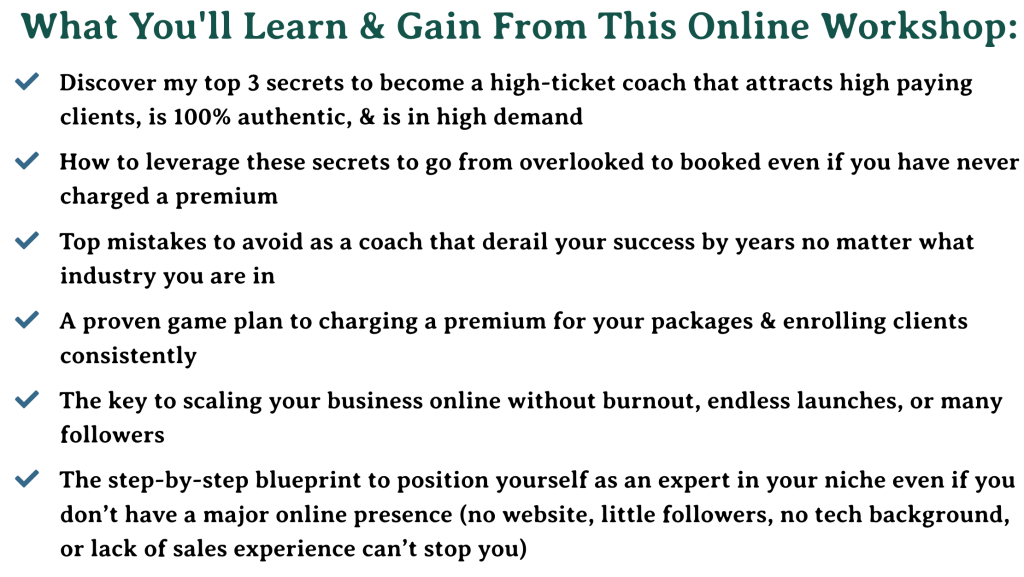
After working with clients in over 20 countries while I was traveling the world, one thing became clear- there are only 24 hours in a day.
A coaching client application helped my ideal clients think through certain challenges they were having and consider what type of support they want before speaking with me. It also repelled the wrong people- rather than just giving them my time and attention on my calendar.
This post is all about coaching client application.
Coaching Client Application
Coaching is a powerful tool for helping individuals achieve their goals and live more fulfilling lives. However, attracting the right clients requires a well-crafted application process that effectively communicates the value of your coaching services and screens for a good fit.
A coaching client application is important to grow a coaching business because:
- Helps to identify potential clients who are a good fit for coaching services.
- Allows coach to gather information about the client’s goals, needs, and expectations.
- Provides a platform to communicate the coaching process and set expectations.
- Offers an opportunity for clients to demonstrate their commitment to the coaching process.
- Enables the coach to screen clients and avoid time-wasting interactions.
In this post, we’ll outline a step-by-step approach for creating a compelling coaching client application.
Step 1: Define your coaching niche and target audience
Before you start creating your application, it’s important to have a clear understanding of who you want to work with and what type of coaching you specialize in.
This will help you attract the right clients and ensure that the application is tailored to your target audience.
Step 2: Develop your application form
Your application form should be user-friendly, concise, and easy to complete. Consider including the following elements:
- Personal information: Name, email, phone number, etc.
- Goals and challenges: What the client hopes to achieve through coaching and the specific challenges they face.
- Background information: Relevant experience, education, and other relevant details that can help you understand the client’s situation and needs.
Step 3: Add an introduction and instructions
Begin your application form with a brief introduction that explains the purpose of the coaching program and the benefits the client can expect to receive. Provide clear instructions for completing the form, including how much time it should take, and how to submit it.
Click here to learn all about high ticket coaching.
Step 4: Ask for referrals and testimonials
Include a section for referrals and testimonials, as these can be valuable for attracting new clients and building trust with potential clients. Ask your existing clients for referrals and testimonials, and include them in your application process.
Step 5: Set up an automated email response
Once you have created your application form, set up an automated email response that is triggered when the client submits their application. This email should thank the client for their interest and provide them with any additional information they may need to prepare for the coaching program, such as scheduling an initial consultation.
Step 6: Review and refine your application process
After you have launched your application process, take the time to review and refine it. Ask for feedback from clients and make changes as needed to ensure that the process is user-friendly and effective in attracting the right clients for your coaching program.
By following these steps, you can create a compelling coaching client application that effectively communicates the value of your coaching services and screens for a good fit. With the right application process in place, you can attract the right clients and help them achieve their goals and live more fulfilling lives.
Top Tools To Build & Create Your Coaching Client Application
The tools mentioned are forms and survey builders that are commonly used for applications and lead generation. They offer various features such as customizable templates, conditional logic, integrations with other tools, and the ability to collect and store responses.
The most appropriate tool depends on the specific requirements and needs of the coaching program and its audience, such as the number of questions, the complexity of the application, and the level of data analysis required.
It is recommended to evaluate each tool based on its features, user-friendliness, and affordability before making a final decision.
- Typeform
- JotForm
- Google Forms (My favorite and easiest to use)
- Wufoo
- SurveyMonkey
- Cognito Forms
- Formstack
- Gravity Forms
- 123FormBuilder
- KForms.
How To Promote Your Coaching Client Application On Social Media
To promote your coaching client application on social media, you can follow these steps:
- Determine your target audience and the platforms they use the most.
- Create a social media strategy that showcases the benefits of using your coaching client application.
- Share testimonials from previous clients about their experiences using the application.
- Offer a special discount or promotion for those who sign up through social media.
- Use visually appealing graphics, such as infographics or videos, to showcase the application’s features and benefits.
- Collaborate with influencers or other coaches in your niche to expand your reach.
- Utilize social media advertising options, such as promoted posts or sponsored ads.
- Engage with your followers by responding to comments and messages, and posting regular updates on your coaching services and application.
Where to Promote Your Coaching Client Application Overall
- Social Media platforms: Utilize platforms like Facebook, LinkedIn, Twitter, Instagram, etc. to reach a wider audience.
- Google Ads: You can run Google Ads to target specific demographics, locations, and interests.
- Content Marketing: Blogging, podcasting, video creation, and other forms of content marketing can help you reach potential clients and establish your expertise.
- Referral Marketing: Encourage your existing clients to refer their friends and family to your coaching services.
- Email Marketing: Build an email list and send targeted email campaigns to promote your coaching services and application.
- Networking Events: Attend local networking events and conferences to connect with potential clients in person.
- Collaborations: Partner with other businesses or individuals in your industry to cross-promote each other’s services.
- Influencer Marketing: Reach out to influencers in your niche and ask them to promote your coaching application to their followers.
Tips to Add Value Via Online Workshops And Promote Your Coaching Client Application
- Interactive activities: Interactive activities such as quizzes, polls, or group discussions, will keep attendees engaged and encourage them to participate in the workshop. This can help to create a sense of community and collaboration among attendees, which will help to build trust and establish a positive relationship with your coaching client application.
- Actionable takeaways: To maximize the value of your workshop, it’s essential to provide attendees with specific, tangible skills or knowledge that they can apply immediately. This could include practical tips, techniques, or strategies that attendees can use to achieve their goals. By providing actionable takeaways, you are demonstrating the value of your coaching client application and helping attendees understand how it can help them achieve their goals.
- Q&A session: A Q&A session is a valuable opportunity for attendees to ask questions and receive answers from an expert in the field. This can help to address any concerns or uncertainties that attendees may have about the coaching client application, and provide valuable insights that will help them make the most of the workshop experience.
- Visual aids: Using graphics, videos, slides, or other multimedia can help to break up the workshop content, keep attendees engaged, and make complex concepts easier to understand. For example, a visual representation of a particular technique or strategy can help to clarify the concept and make it easier to remember.
- Personalization: Making the workshop personal can help to establish a connection with attendees and create a more memorable experience. By addressing attendees by name, acknowledging their unique needs and challenges, and tailoring the content to their specific interests and goals, you can create a workshop that is both engaging and valuable.
- Encouraging feedback: Encouraging attendees to provide feedback on the workshop and the coaching client application can help you to understand their needs and improve the experience. This can be done through surveys, questionnaires, or even a dedicated Q&A session at the end of the workshop.
- Special promotions: Offering special promotions, discounts, or bonuses for attendees who sign up for the coaching client application during or after the workshop can provide an added incentive for attendees to take action. This can help to turn workshop attendees into paying clients and increase the overall value of your workshop.
How to Charge For Your Coaching Client Application
Charging for your coaching client application is important for several reasons:
- Sustainability: Charging for your coaching application provides a revenue stream that can help ensure the long-term sustainability of your business.
- Validation: When people are willing to pay for your services, it’s a sign that they value what you’re offering and believe it’s worth the investment.
- Professionalism: By charging for your services, you demonstrate that you take your coaching business seriously and value your time and expertise.
- Competitive advantage: By charging, you differentiate yourself from free or low-cost competitors and can position your coaching services as premium offerings.
- Revenue generation: Charging for your coaching application is an opportunity to generate revenue, which can be reinvested into your business to further grow and improve your services.
In short, charging for your coaching client application provides a way to sustain, validate, professionalize, differentiate, and generate revenue for your business.
There are several options for charging clients for a coaching application:
- Hourly rate: Charge based on the time spent on coaching sessions.
- Package deal: Offer several packages at different prices, each including a set number of sessions.
- Subscription model: Charge a recurring fee, such as monthly or quarterly, for access to the coaching application.
- One-time fee: Charge a single, upfront fee for lifetime access to the coaching application.
- Tiered pricing: Offer different levels of service at different prices, with each level providing more features or benefits.
It’s important to consider factors such as the value you’re providing, the market rate for similar services, and your target client demographic when determining your pricing strategy.
This post was all about coaching client application.





